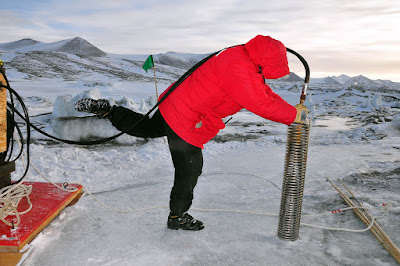
I've been remiss by not introducing the members of our 2011 research team. I'll post more complete introductions and detail each person's role in the project at a later date. For now, from left to right:
Laura Von Rosk - Art/science collaborator (Schroon Lake, NY)
Cecilia Shin - Lead research diver and camp safety officer (University of California Santa Cruz)
Dr. Jan Pawlowski - Molecular protistologist (University of Geneva, Switzerland)
Danielle Woodward - Youngest research diver in Antarctica (Hilo, HI)
Hilary Hudson - Research diver, documentary film maker
Dr. Sam Bowser - Principal Investigator (Albany, NY)
Dr. Andrew Gooday (pictured below in the Explorers Cove lab) - Biological oceanographer (National Oceanography Centre, Southampton, U.K.)
Our project centers on characterizing the ~20 new species of foraminiferan protists we have identified in past work, and on obtaining information on the genetics of these organisms.
More about that as results pour in!






















 Henry Kaiser took this IR picture of me checking outside conditions from the comfort of the Crary Lab. Wind-blown snow obscured the view, and I could feel the cold oozing through the window. (Ooops, that statement will get my thermodynamics prof turning in his grave ... OK, it's heat transferring from the air surrounding the window that I'm perceiving.)
Henry Kaiser took this IR picture of me checking outside conditions from the comfort of the Crary Lab. Wind-blown snow obscured the view, and I could feel the cold oozing through the window. (Ooops, that statement will get my thermodynamics prof turning in his grave ... OK, it's heat transferring from the air surrounding the window that I'm perceiving.)






